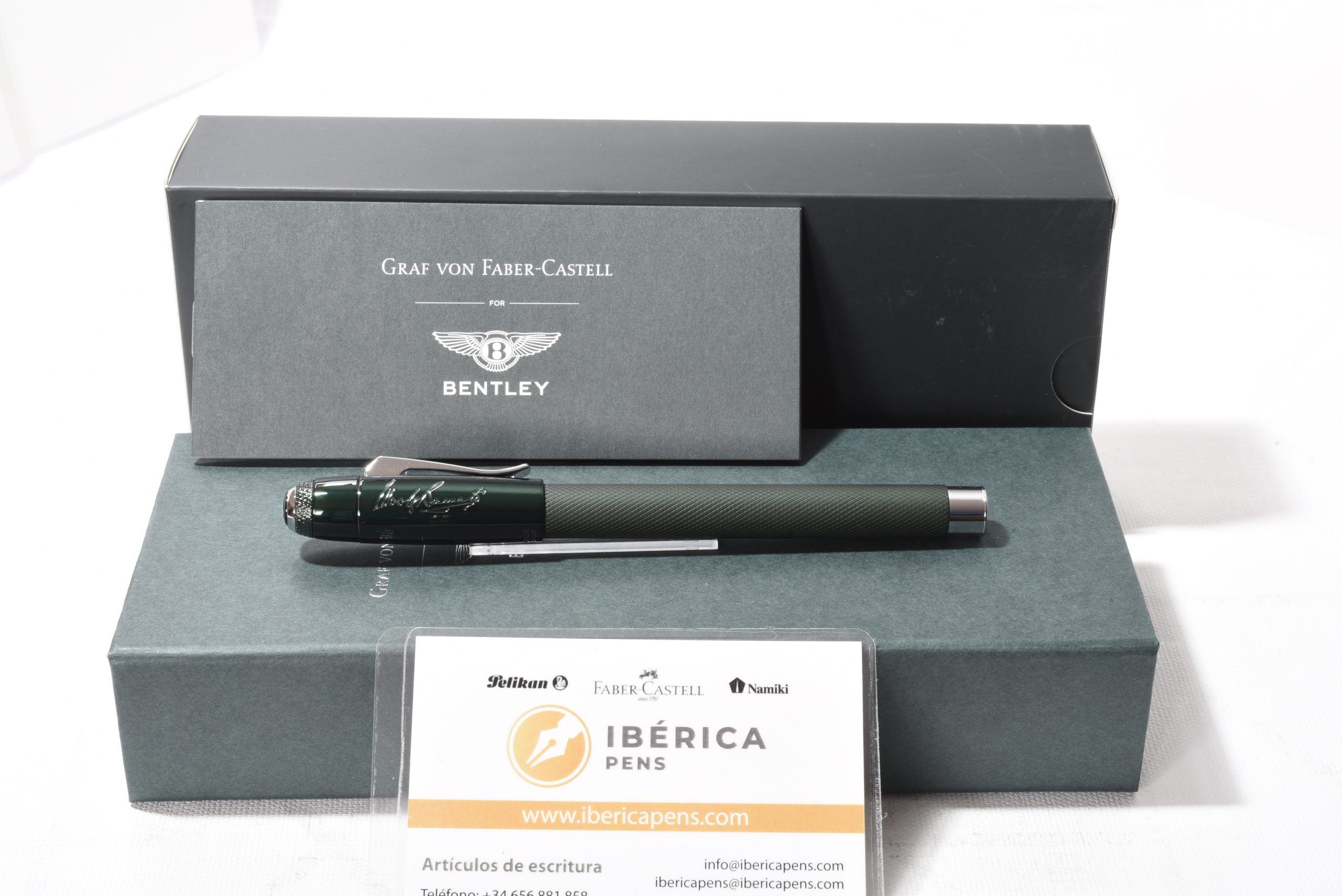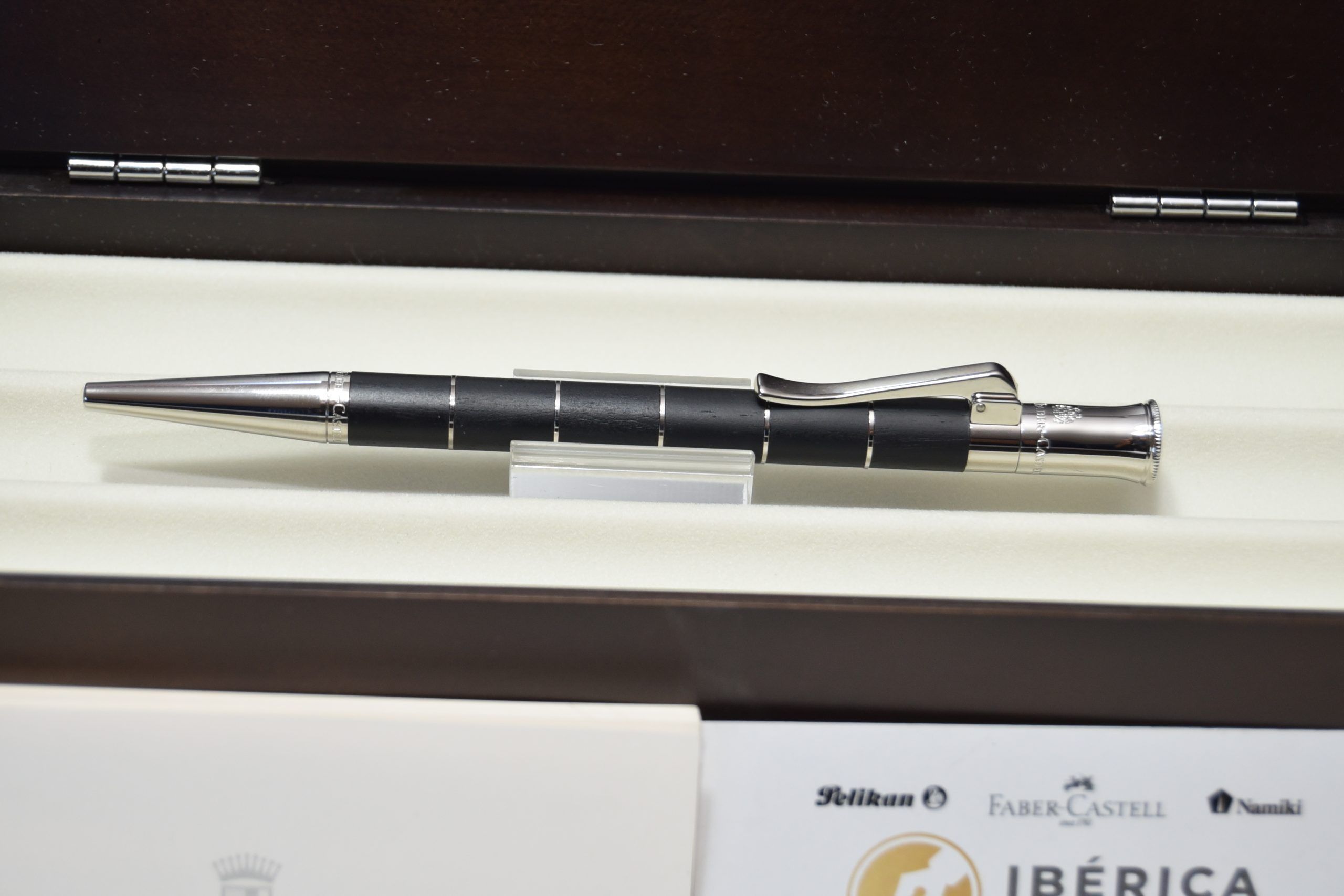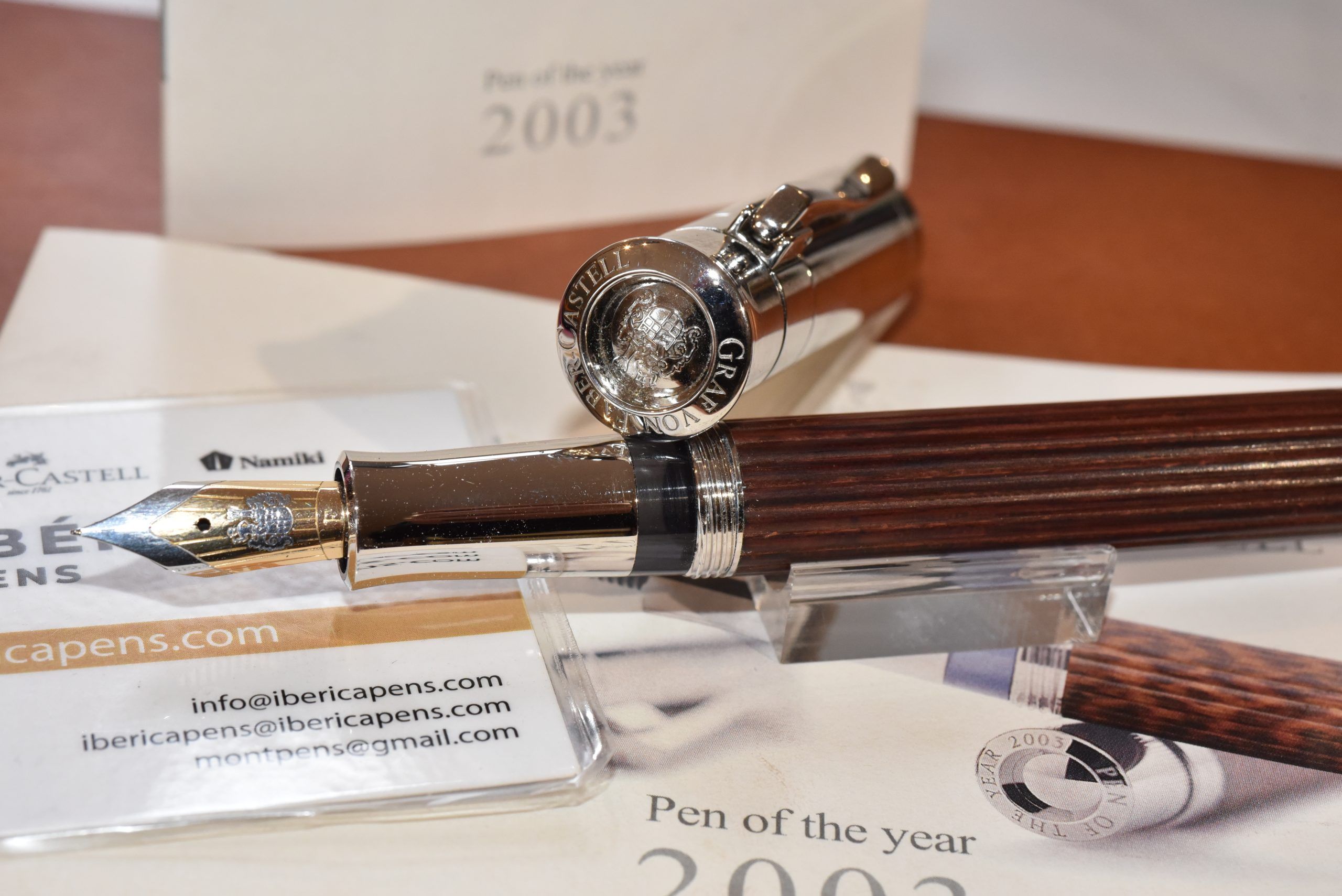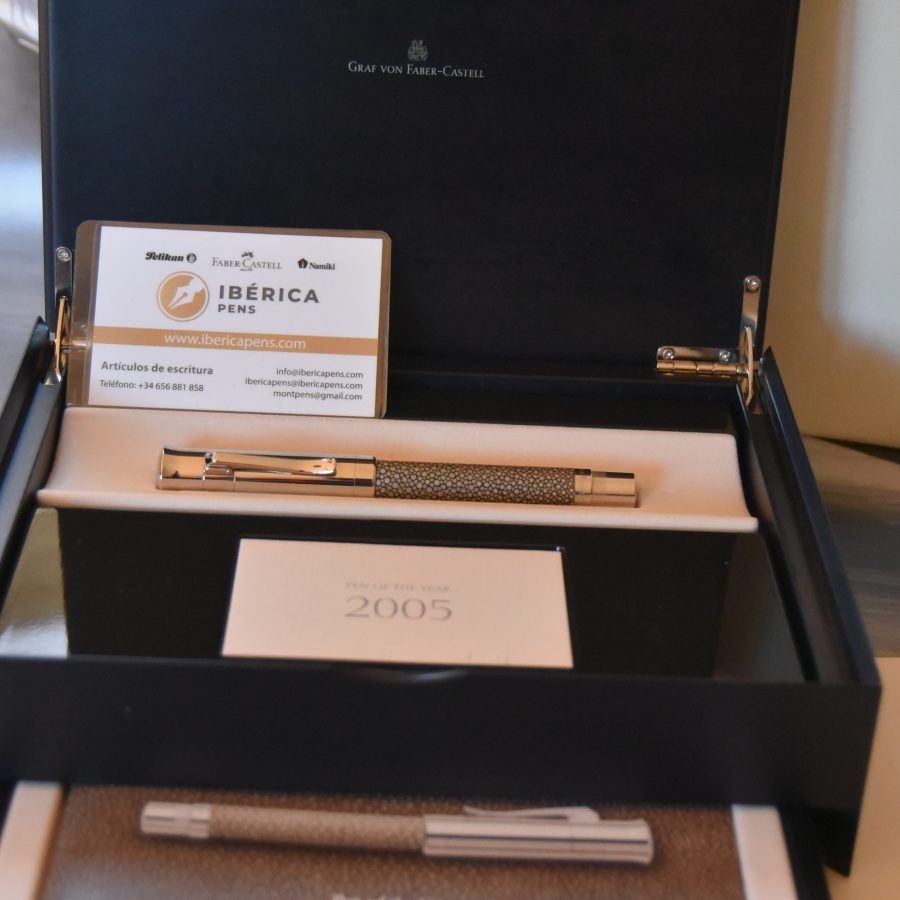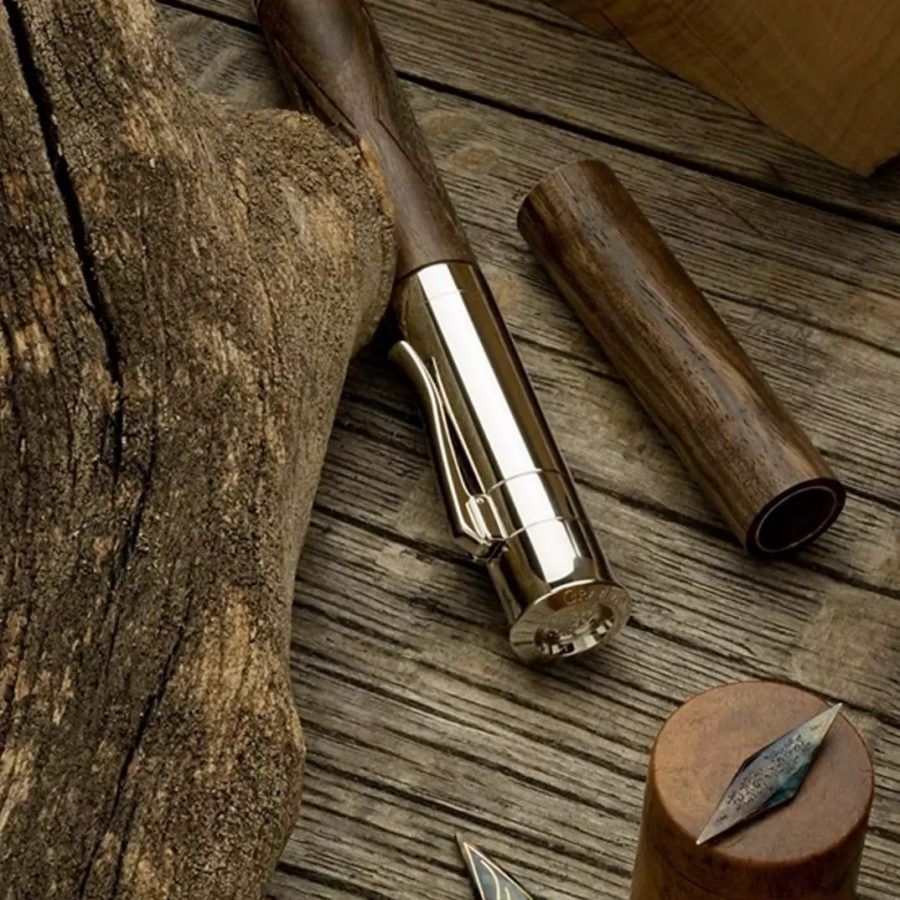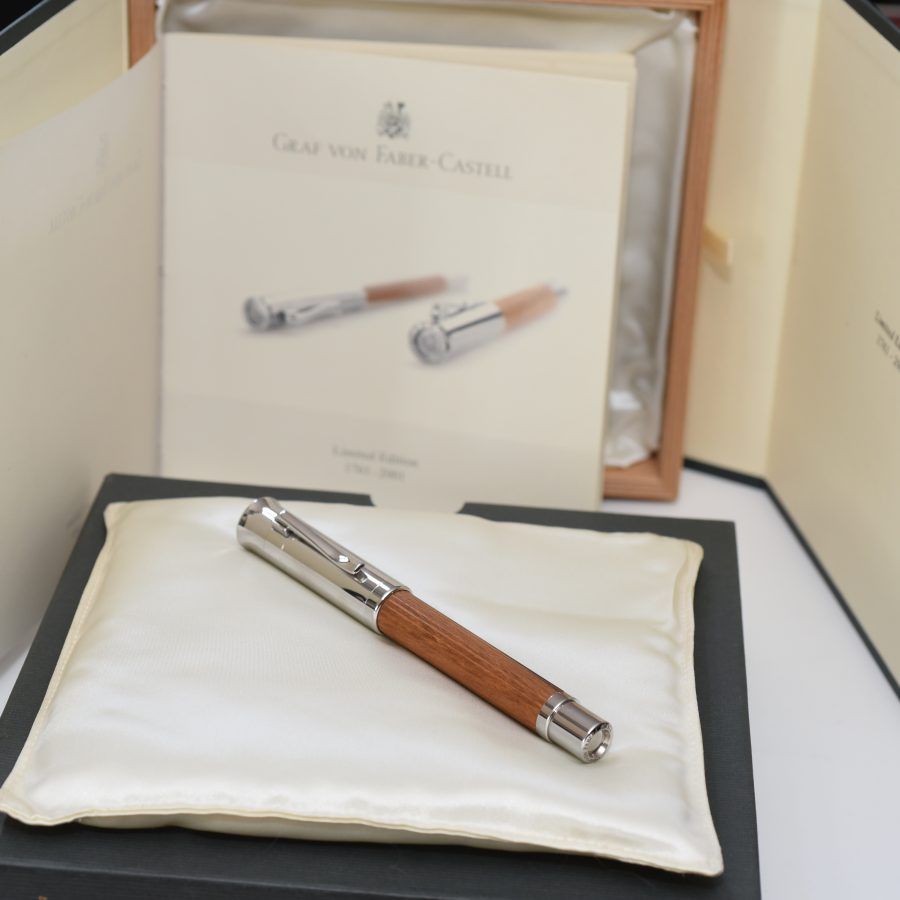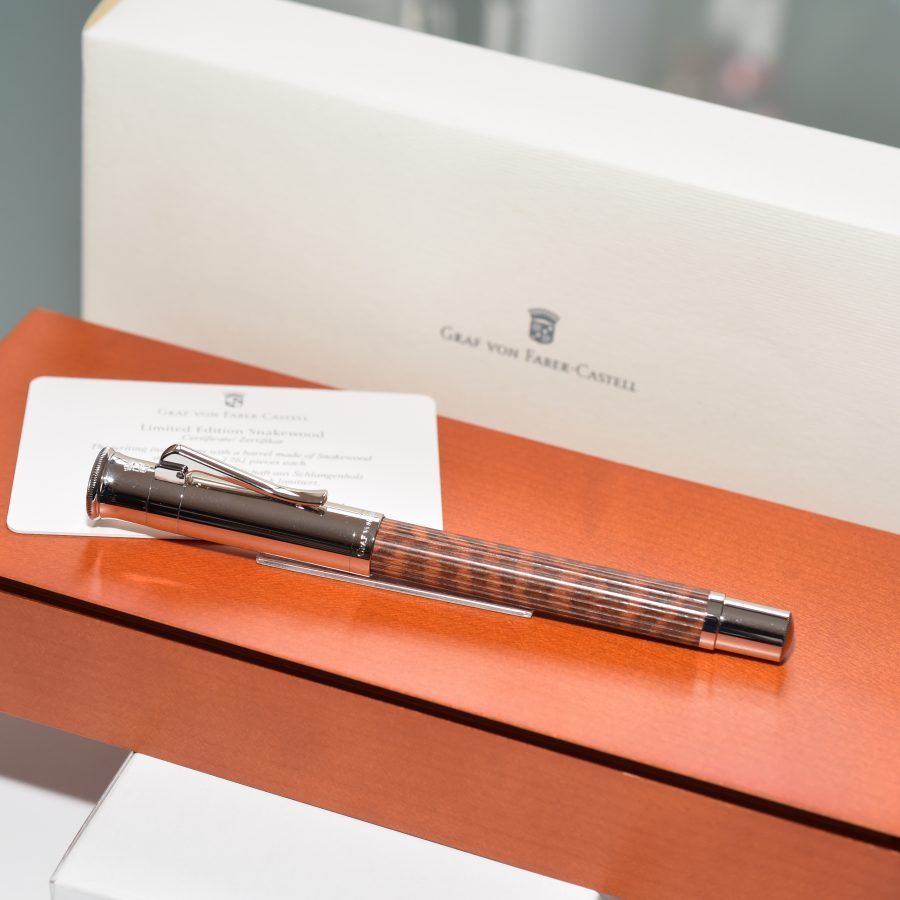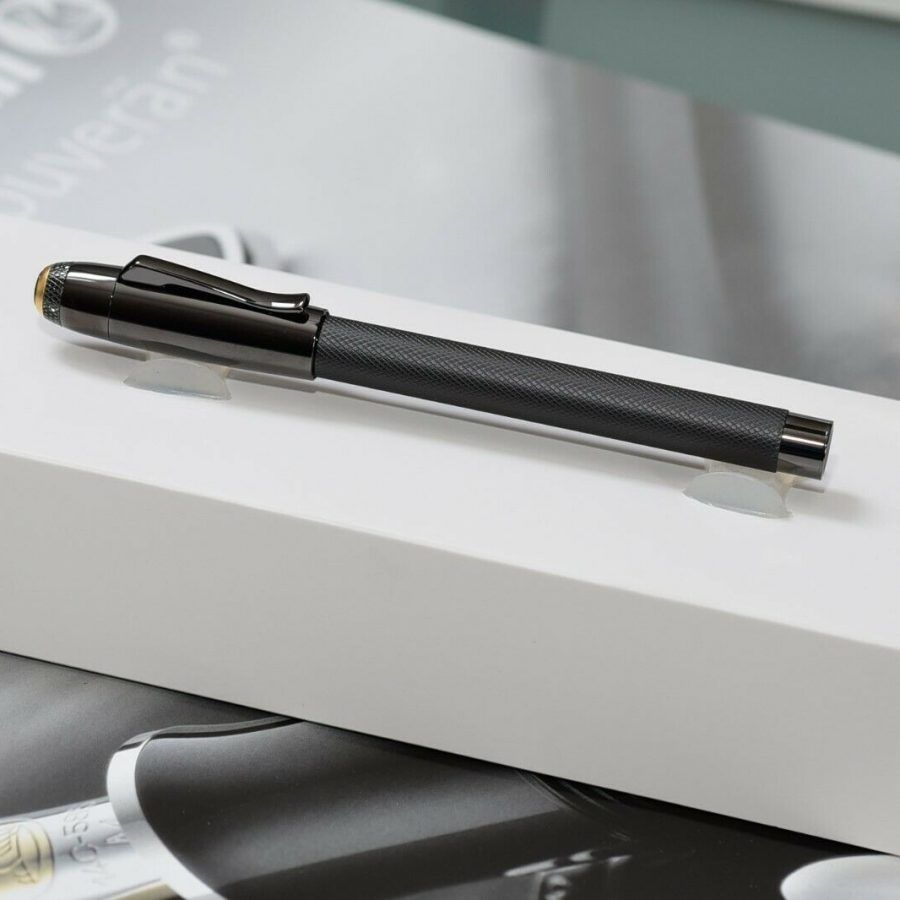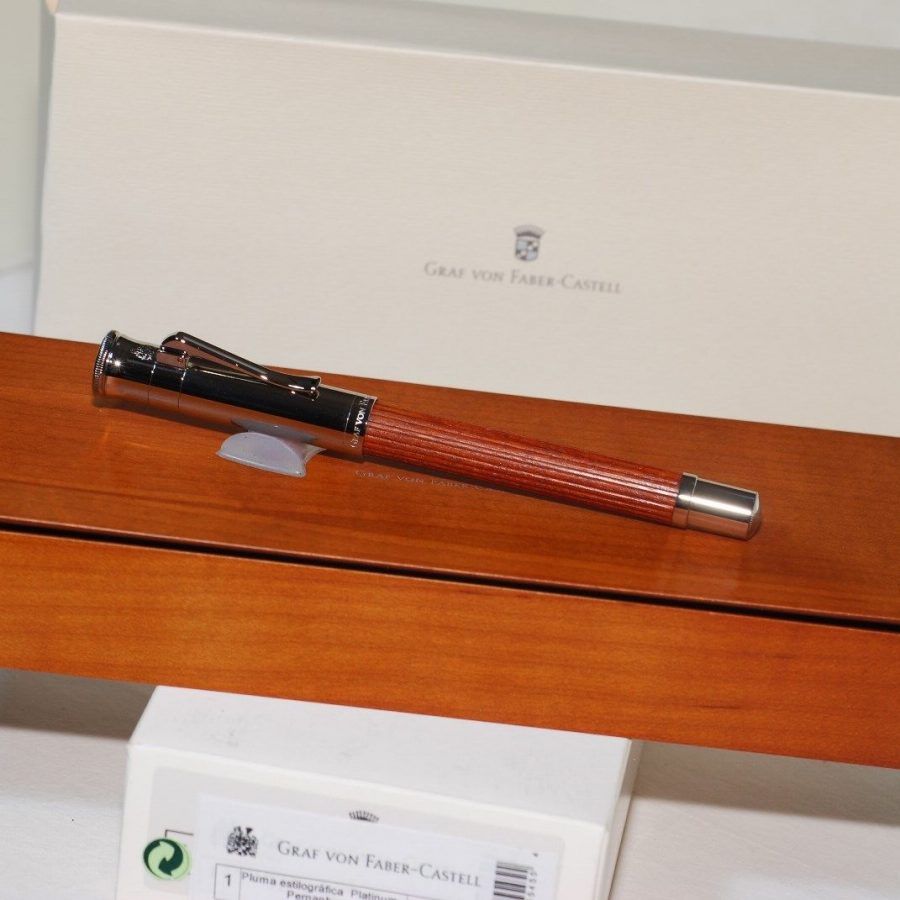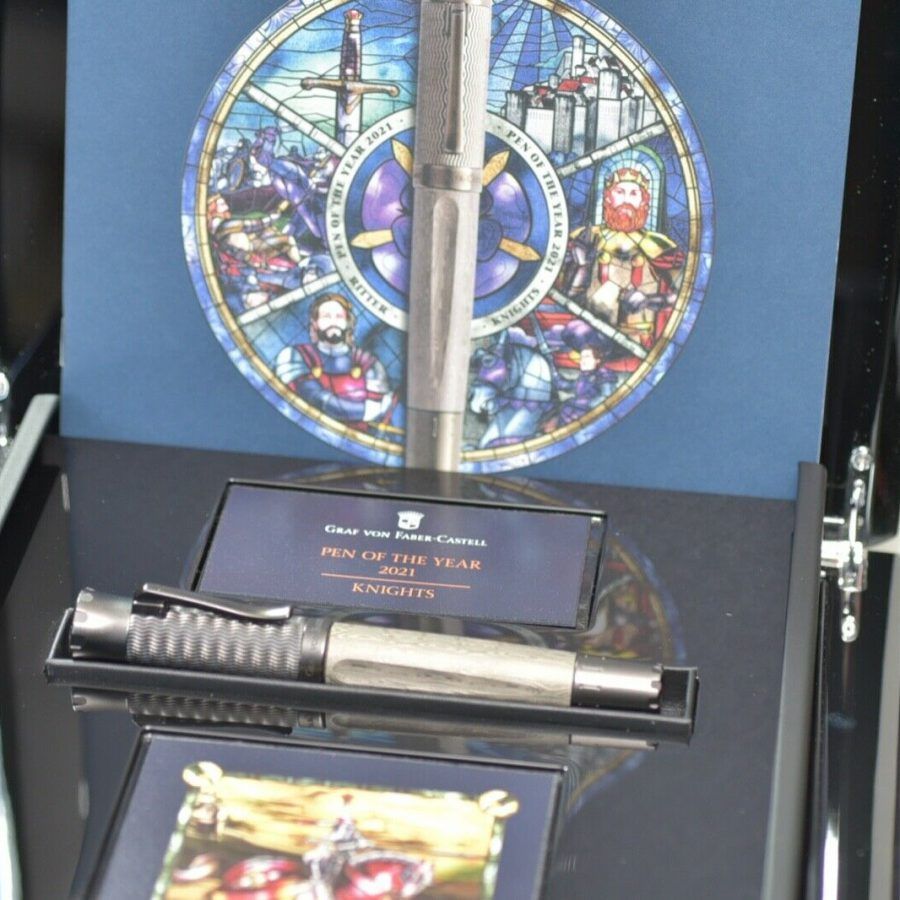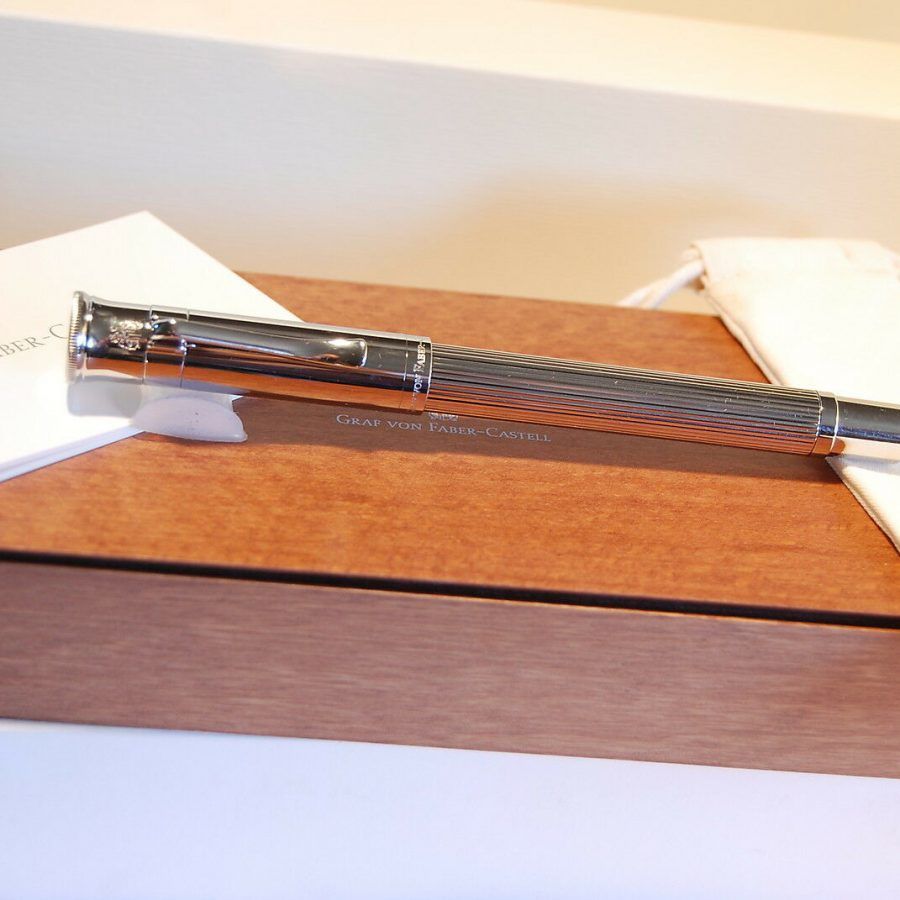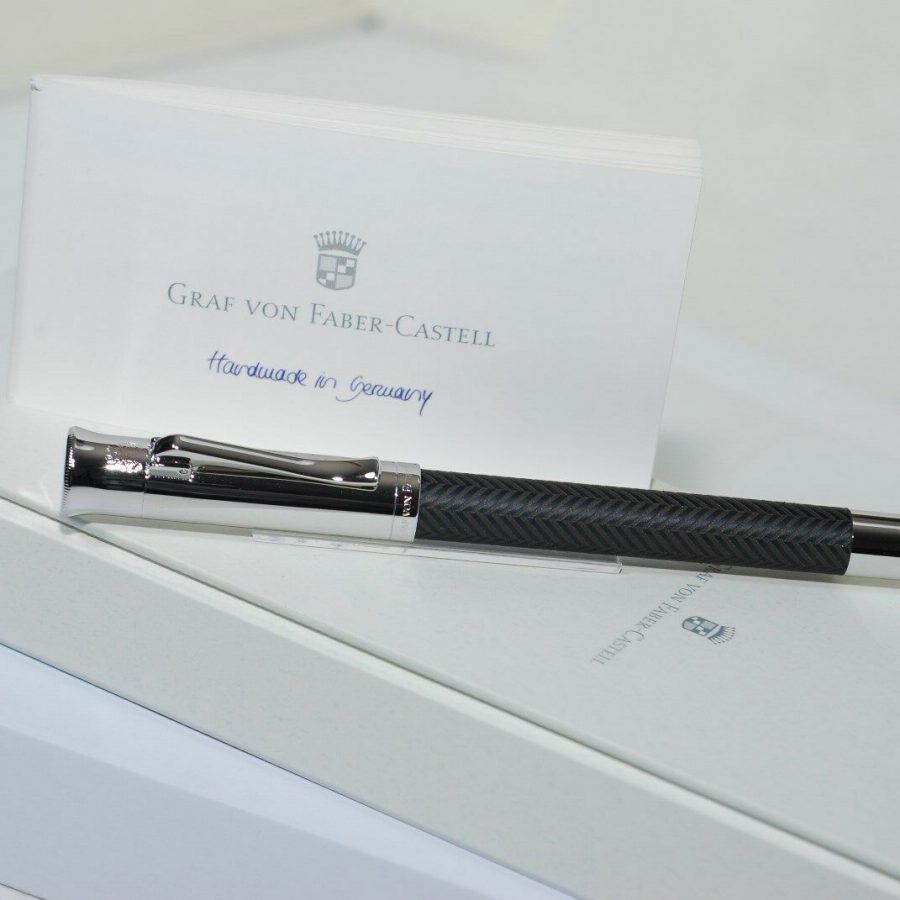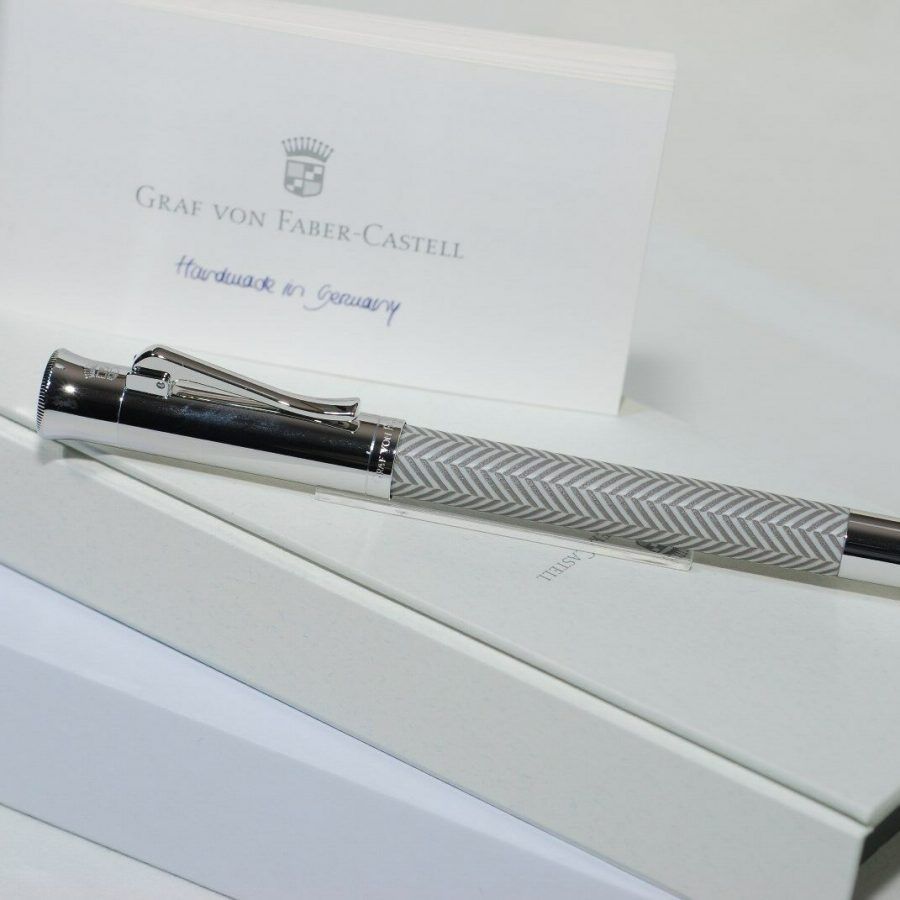Faber Castell
Showing 1–16 of 19 resultsSorted by latest
-
![]()
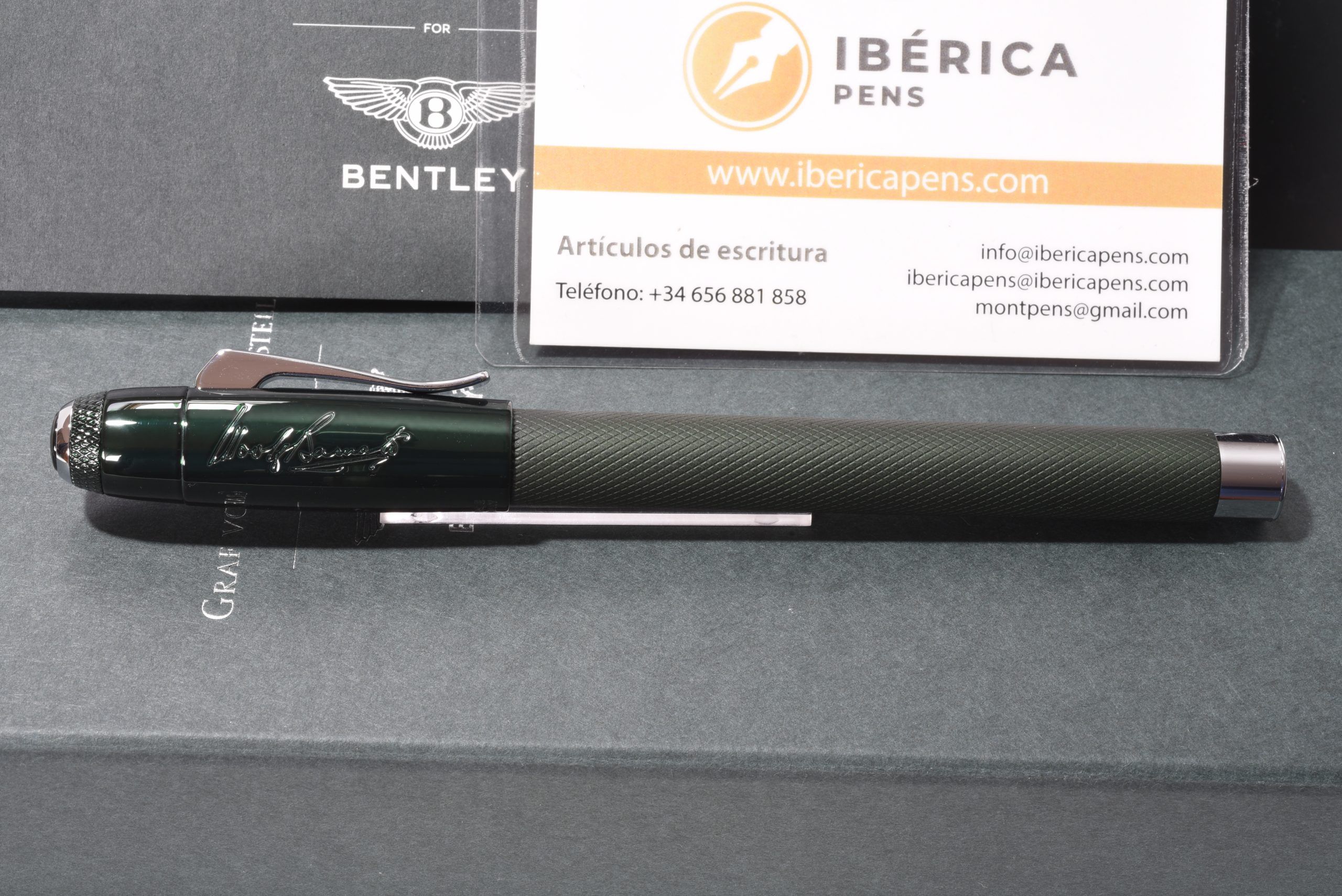
Faber Castell for Bentley Limited Edition Barnato fountain pen
550,00€Fountain pen Bentley Limited Edition Barnato
To celebrate the 90th anniversary of Woolf Barnato’s “Blue Train” race, Graf von Faber-Castell and Bentley have collaborated to create a truly unique writing instrument, with the highest standards of craftmanship. Barnato famously made a bet that he could defeat the “Blue Train Express” from Cannes to London. To commemorate this piece of Bentley’s history, this limited-edition pen is engraved with Barnato’s signature. A reminder of the extraordinary spirit that lives on at Bentley today.
-
![]()
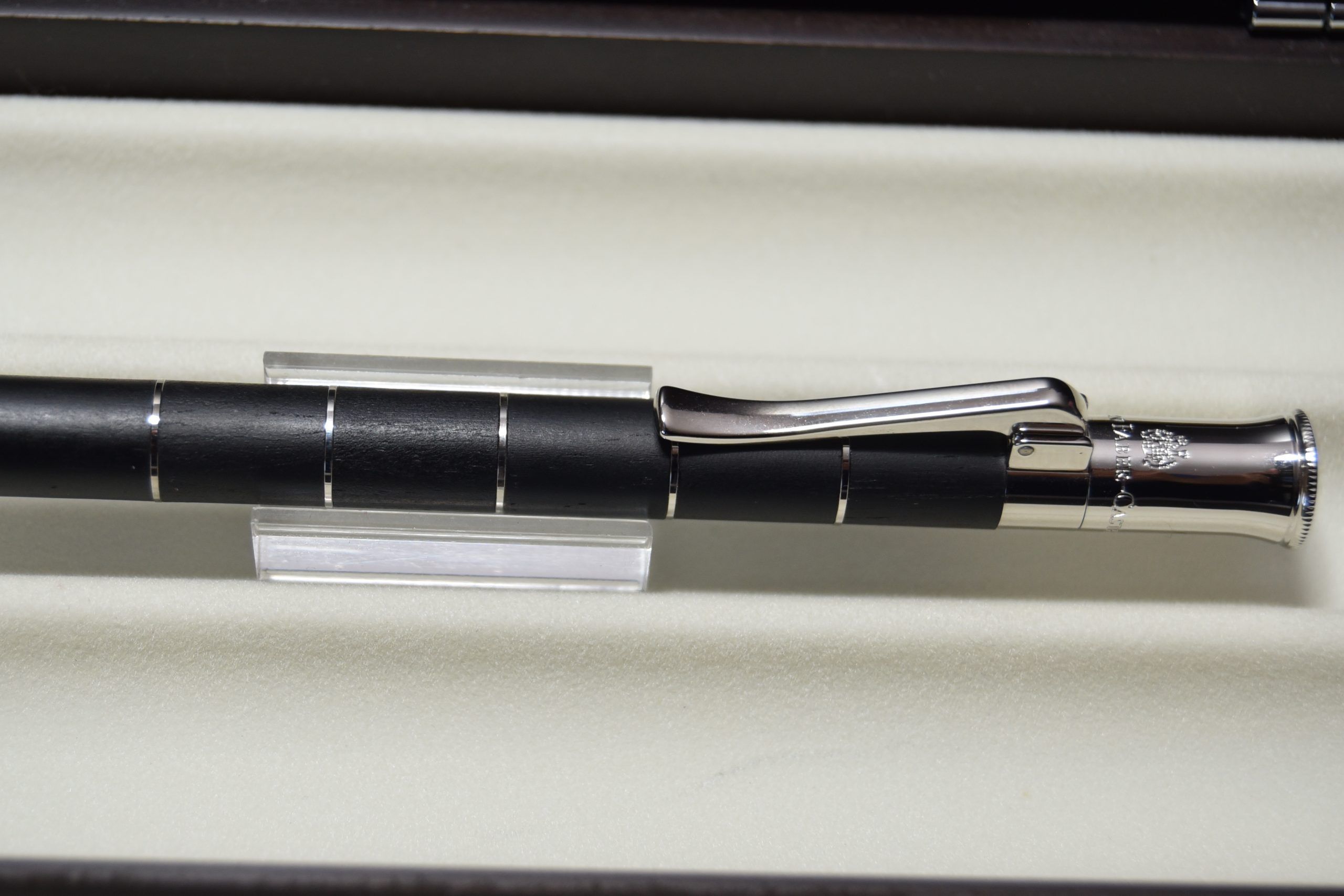
Faber CastellClassic Anello ebony ballpoint pen
300,00€Classic Anello ebony ballpoint pen
The Anello Classic line illustrates how the culture of writing can be enriched with surprising nuances. Fascinating contrasts and noble materials distinguish the different versions of the Anello Classic line. Multiple segments separated by thin platinum rings give the series its name: anello is the Italian word for ring.
-
![]()
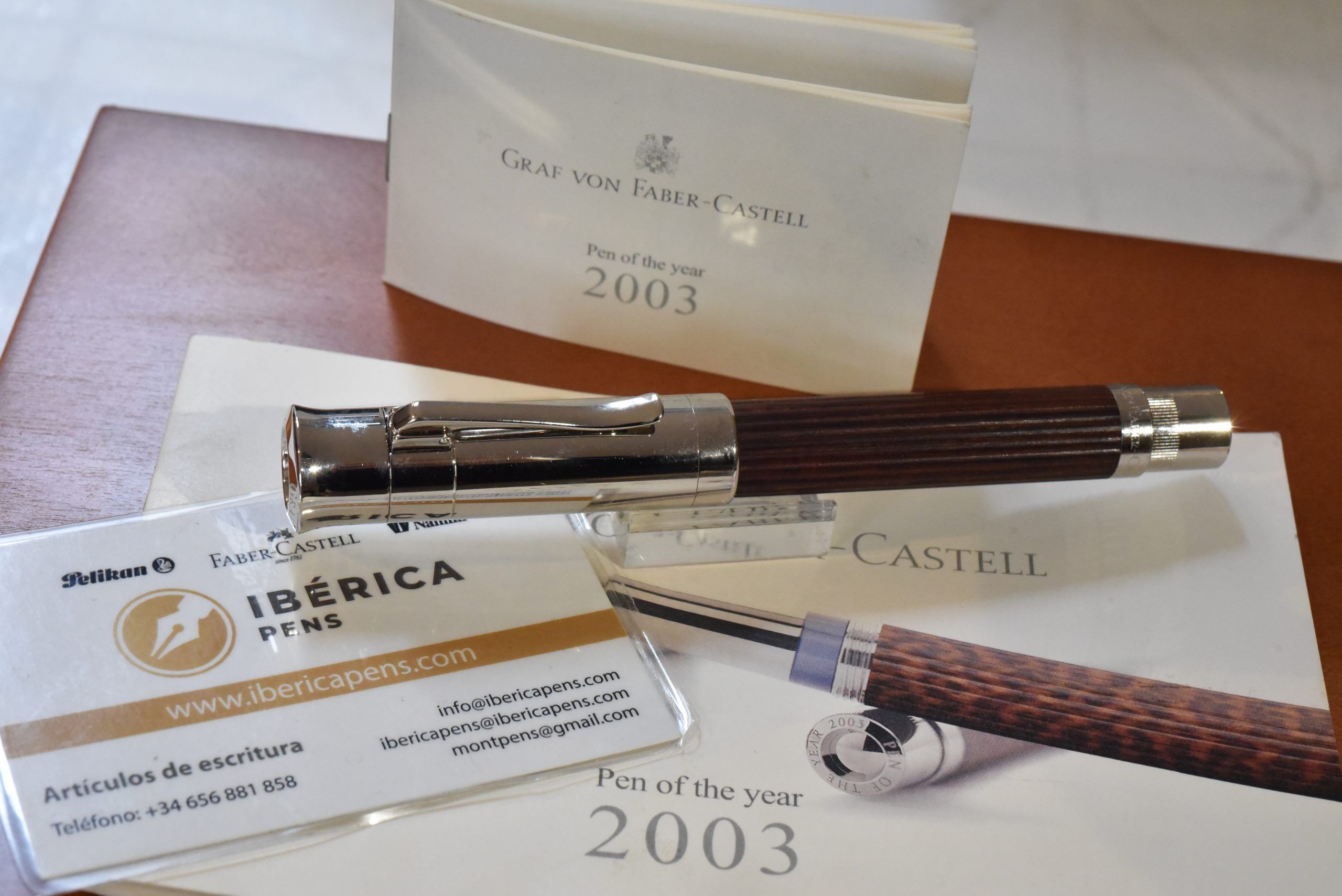
Graf Von Faber Castell Pen of the Year snakewood 2003 Fountain Pen
3.500,00€Personal style
nib size F
The hand-tested two-tone 18-karat gold nib comes in three line widths. The rotary knob of the plunger mechanism, which is a masterpiece in precision and design, is protected by a platinum-coated cap to prevent possible dripping.
Limited: 1,500 fountain pens
-
![]()
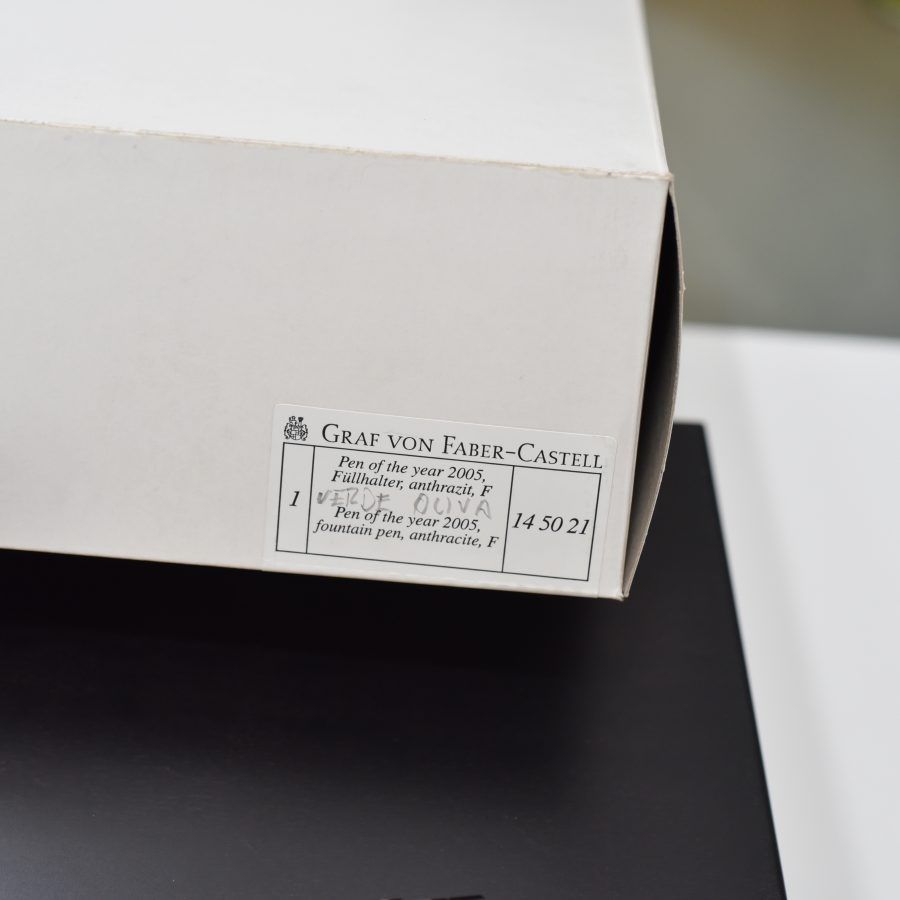 This product has multiple variants. The options may be chosen on the product page
This product has multiple variants. The options may be chosen on the product pageFountain Pen Graf Von Faber Castell Year 2005 Galuchat Olive Green
2.200,00€Small dent on one corner of the box, unnoticeable.
THE ESSENCE OF WRITING
Mysterious inner beauty and utmost practicality may have been the reason for the Samurai to cover their sword handles with stingray leather. Each and every detail of these masterly weapons expresses the desire to liberate the spirit from any deliberate effort.
“To wield a sword, ride a horse, write – do it in such a manner as if you were not wielding a sword, not riding a horse, not writing. Then you accomplish everything without resistance, yet with spirit and ease”, the legendary Samurai Yagyu Munenori said. The stingray fountain pen is perfectly suited for discovering that sense of ease.
-
![]()
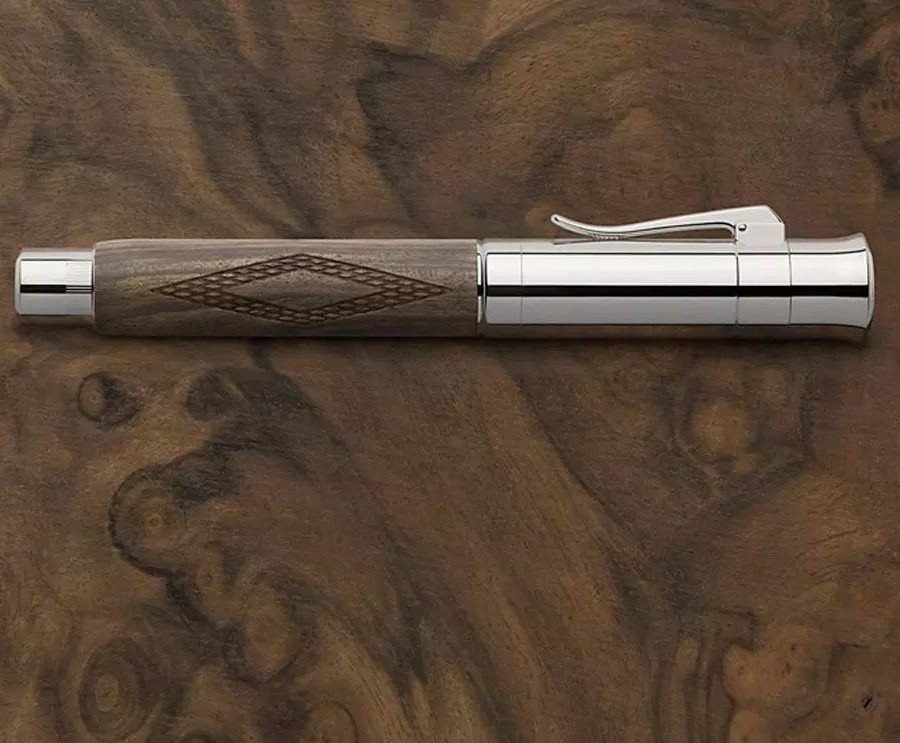
Graf Von Faber Castell Pen Of The Year 2010 Wood Of Walnut
2.800,00€A secret art of original aesthetics
Looking at the 2010 Special Edition, you are fascinated by the interplay of delicate engravings and elegant marbled steel parts.Until the end of the 19th century, the marbling of steel was a sign of the high quality of a weapon, given the inimitable shine it provided. For centuries, this process was passed on by word of mouth and kept a jealous secret.
Metal surfaces were steeled by using charred leather, generating shifting color hues when cooled. To date, it has been found that up to 20 parameters converge to generate this surprising visual effect, among which are the thickness of the metal, the temperature and the cooling speed.
Shifting color hues
Extensive experience in craft work can influence results, but never accurately anticipate them. Thus, no two marbled metals are completely alike.The metal surface is perfected according to an elaborate engraving process framed with 24-karat gold inlays. Today very few workshops can combine these traditional arts with the mastery required by the 2010 Special Edition.
Before tempering the steel, the pen of the year is engraved through a traditional process. The engraver hand chisels the dovetail guide into which the gold inlay is inserted for subsequent polishing. A final result that requires great skills and precision for perfection
-
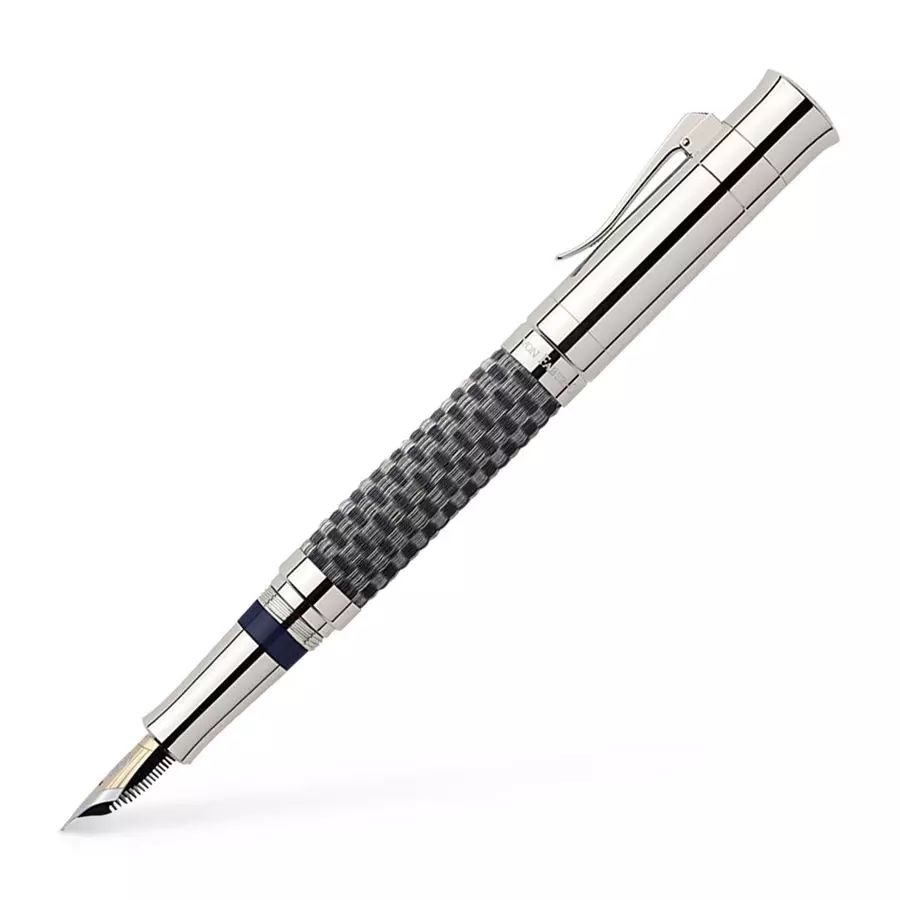
Graf Von Faber Castell Pen Of The Year 2009 horsehair fountain pen
2.800,00€An almost forgotten art
Making the highest quality horse hair weaving is an art that only a few master weavers have learned to master.
Few experts in Germany enjoy the status of Dorit Berger. “I always wanted to learn to spin. There is something magical about it. And the fascination has never left me ”. After thoroughly training as a master weaver, she discovered for herself the uniqueness of a material such as horse hair weft.Horse hair texture is quite a challenge. The hairs on the tail are relatively short and stiff and cannot be spun in a continuous skein. They can’t actually be braided in a conventional way.
To create the filigree design of the 2009 Special Edition, the hairs must be carefully selected for uniform color and thickness. It takes 70 individually woven hairs to get one centimeter of weft. It is an extraordinarily laborious task that goes hair by hair creating a braiding with a changing texture, light and dark, in surprising contrast to the warmth of the platinum-plated metal parts. As the nuances vary depending on the position of the piece, each horse fur fountain pen becomes a unique work of art.
-
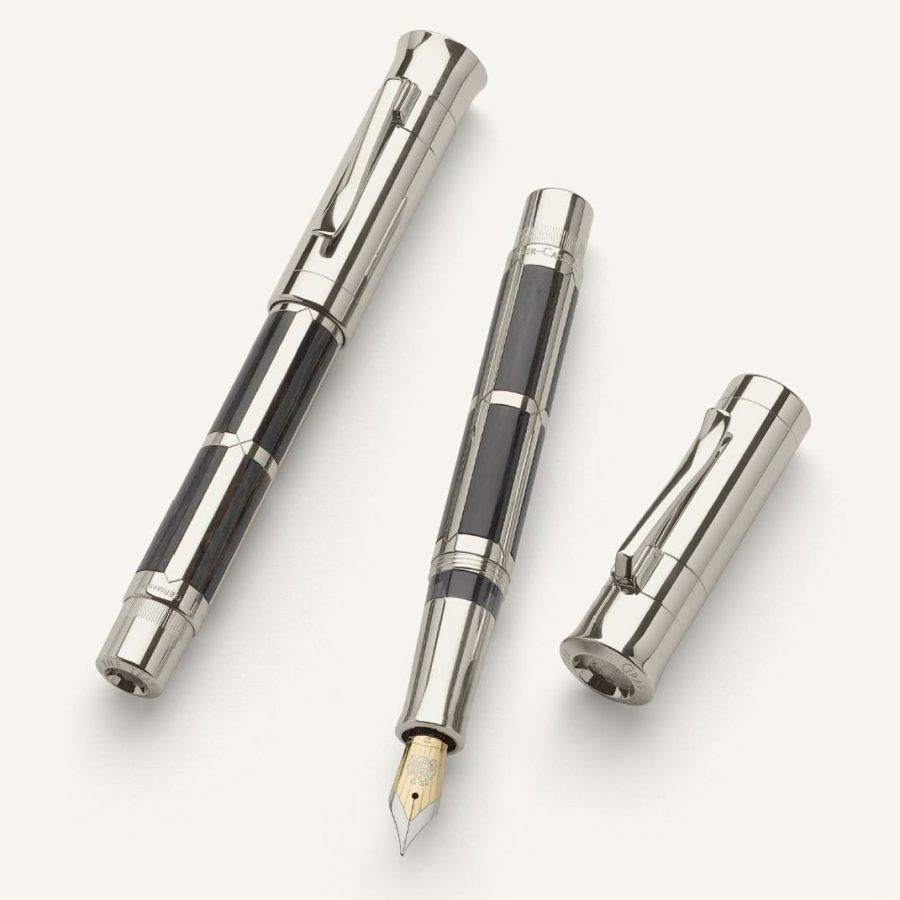
Graf Von Faber Castell Pen Of The Year 2007 pertrified wood fountain pen
2.900,00€Precious like diamond
The use of petrified wood to make the body of a fountain pen is an unusual twist on the history of magnificent woods in the Graf von Faber-Castell collection.
The Brazilian frond wood was specially selected based on its resistance for high quality carving. Unique in the way it blends hues, this striking petrified wood fuses changing shades of color. Tonalities that flow from light brown and go through anthracite gray to lead to an intense black where the veins are almost imperceptible.
The deep but understated luster of this exceptional stone creates a feeling that lasts over time.
-
![]()
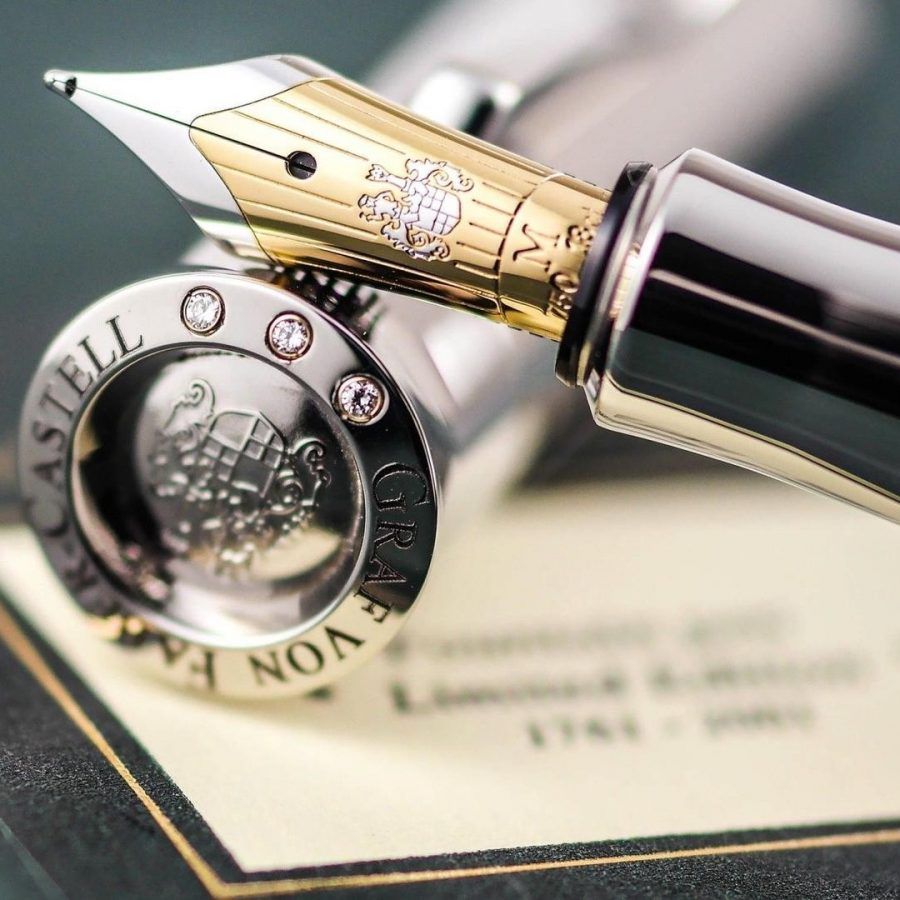
GRAF VON FABER CASTELL 2001 FOUNTAIN PEN 240º ANIVERSARY
3.000,00€Three diamonds adorn the cap of the new limited edition Graf von Faber-Castell fountain pen, a limited edition from 1761, representing the year the company was founded. The silhouette is larger than that of the classic Graf von Faber-Castell fountain pen model.
The fluted body is made from the wood of the Cretan olive tree, which was specially selected for this limited edition. All metal parts are made of stainless steel. The fountain pen has a two-tone 18k gold ni
-
![]()
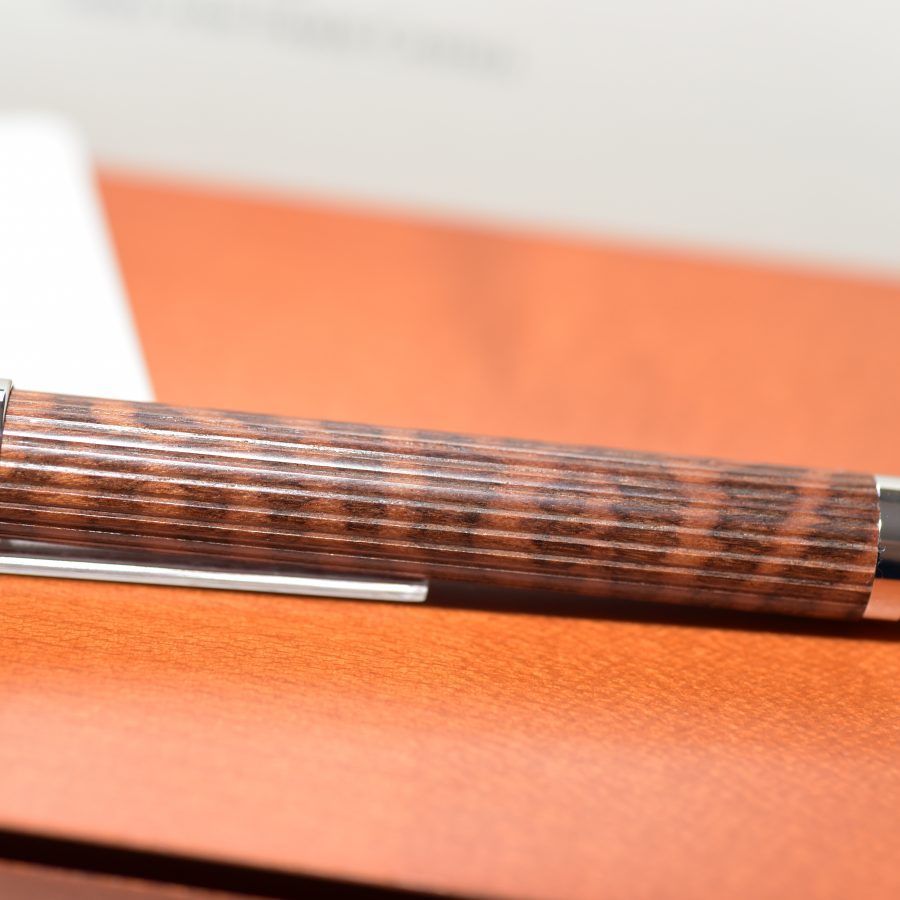 This product has multiple variants. The options may be chosen on the product page
This product has multiple variants. The options may be chosen on the product pageGraf von Faber Castell Limited Edition Fountain Pen Snake Wood
695,00€Limited Edition Fountain Pen Snake Wood
Taking as inspiration the founding date of the Faber-Castell company in 1761, this exclusive edition has been limited to 1,761 pieces. The edition is engraved on the ring of the fountain pen, roller, mechanical pencil and ballpoint pen.Product Details
* Reddish brown veined snake wood body
* Cartridge / converter system
* Two-tone 18-karat gold nib with iridium tip
* The elaboration of the nib is an artisan process of more than one hundred steps, most of them carried out by hand
* Each nib is hand tested
* Available strokes: M (medium), F (fine), EF (extra fine) and B (wide) -
![]()
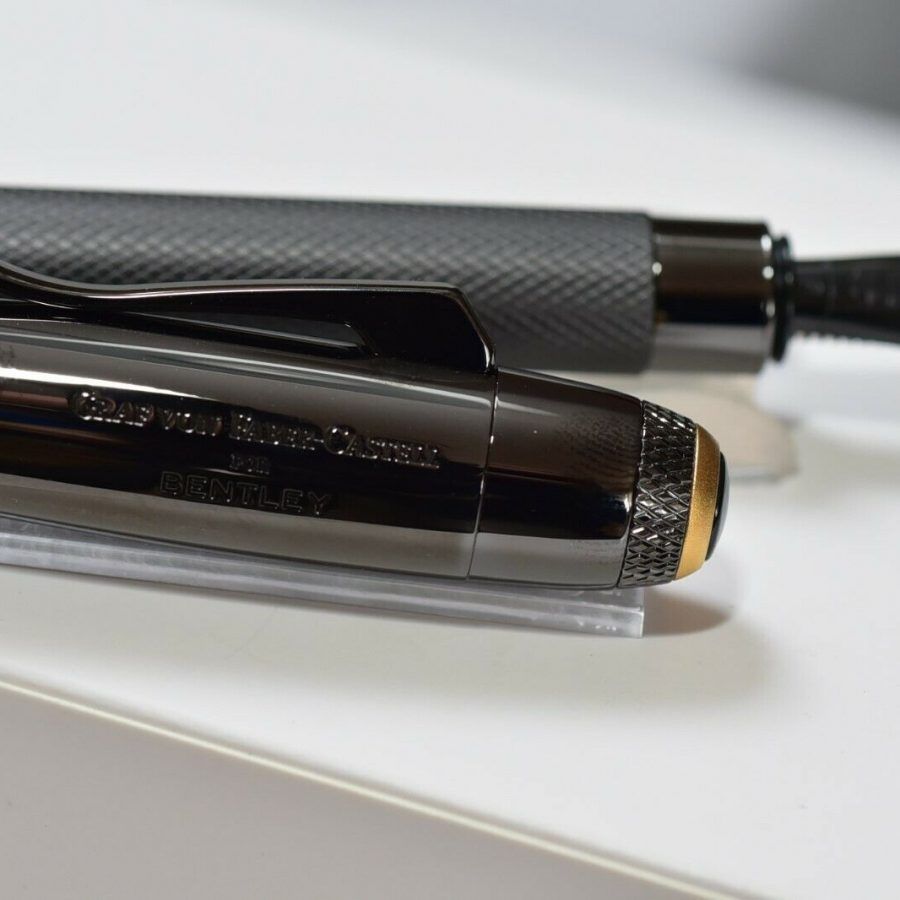
Graf Von Faber Castell for Bentley Limited Edition Centenary Medio fountain pen
475,00€Product Details
Cartridge / converter system, converter included
Stainless steel nib with PVD coating
Available strokes: M (medium), F (fine), EF (extra fine) and B (wide)
Metal body with PVD coating, decorated with an elaborate diamond pattern applied in the Guilloche style
High gloss polished PVD coated metal parts
Refined cap with Bentley B and signature knurling
A 24-karat gold-plated filigree ring at the top of the cap pays tribute to the centennial gold of
Bentley
Solid spring clip
Presentation in gift box
Más información sobre este texto de origenPara obtener más información sobre la traducción, se necesita el texto de origen
Enviar comentarios
Paneles laterales -
![]()
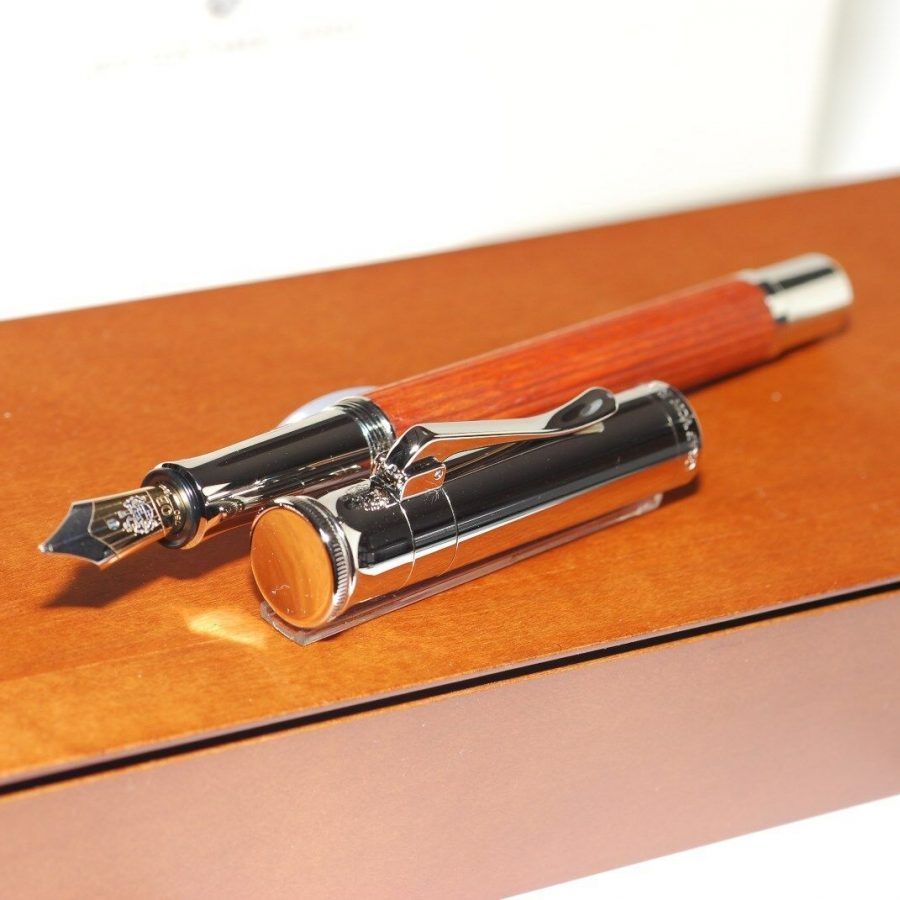
Graf Von Faber Castell Classic Pernambuco Fountain Pen New
425,00€Feeling and intellect
The feeling conveyed by a noble fountain pen with a gold nib remains incomparable. The slender shape and good balance of the Classic propelling pencil and ball pen mean that they sit comfortably in the hand. Well engineered mechanisms and robust details, such as the spring-loaded clip made of solid metal, ensure that the joy of using them is as timeless as the design.
The Classic writing implements come in platinum-plated versions, in ebony, in pernambuco or in grenadilla wood, each combined with platinized fittings and a finely ribbed barrel. The natural differences in grain and colour mean that every writing instrument made from them is unique.
The style of the Classic collection combines the natural and warm charisma of wood with the cool elegance of platinum-plated surfaces in a unique way.The Classic writing implements come in platinum-plated versions, in ebony, in pernambuco or in grenadilla wood, each combined with platinized fittings and a finely ribbed barrel. The natural differences in grain and colour mean that every writing instrument made from them is unique.
- Cartridge/converter system that slides gently out of the barrel on turning the end cap
- Hand-made bicoloured 18-carat gold nib with iridium tip, “run in” by hand
- Manufacturing process involves over a hundred steps, most of them carried out by hand
- Available in different nib widths
-
![]()
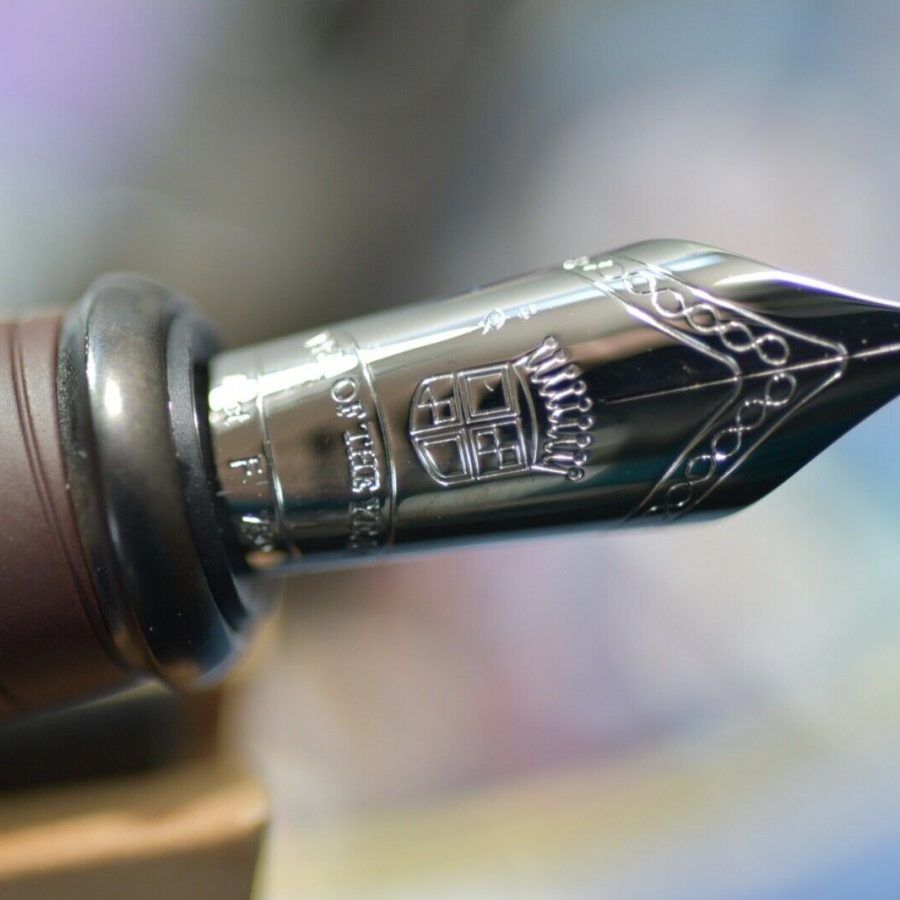
Graf Von Faber Castell Pen Of The Year 2021 L.E. Knights fountain pen
4.700,00€Productdetails
- Plunger-type fountain pen with handmade 18-carat gold nib (ruthenium- coated, magnum-sized)
- Available nib widths: F (fine).
- Damascus steel barrel which, extraordinary properties are achieved through repeated welding and folding
- Milled, brown lacquered grip zone recreates the leather strap on the sword’s grip
- Matt cap with anthracite-grey surface with durable PVD titanium coating is reminiscent of the delicate structure of chain mail
- Top of the cap is adorned by the “heraldic cross”, also known as the “cross of hope”, as it was considered a symbol of hope in the Middle Ages
- End piece is adorned with a red, faceted garnet with sunray cut
- Limited to 375 pieces
- All writing instruments are individually numbered
- Delivered in a black, highly polished wooden box (including brochure and certificate of authenticity)
- Additional insert offers space for six more writing instruments
-
![]()
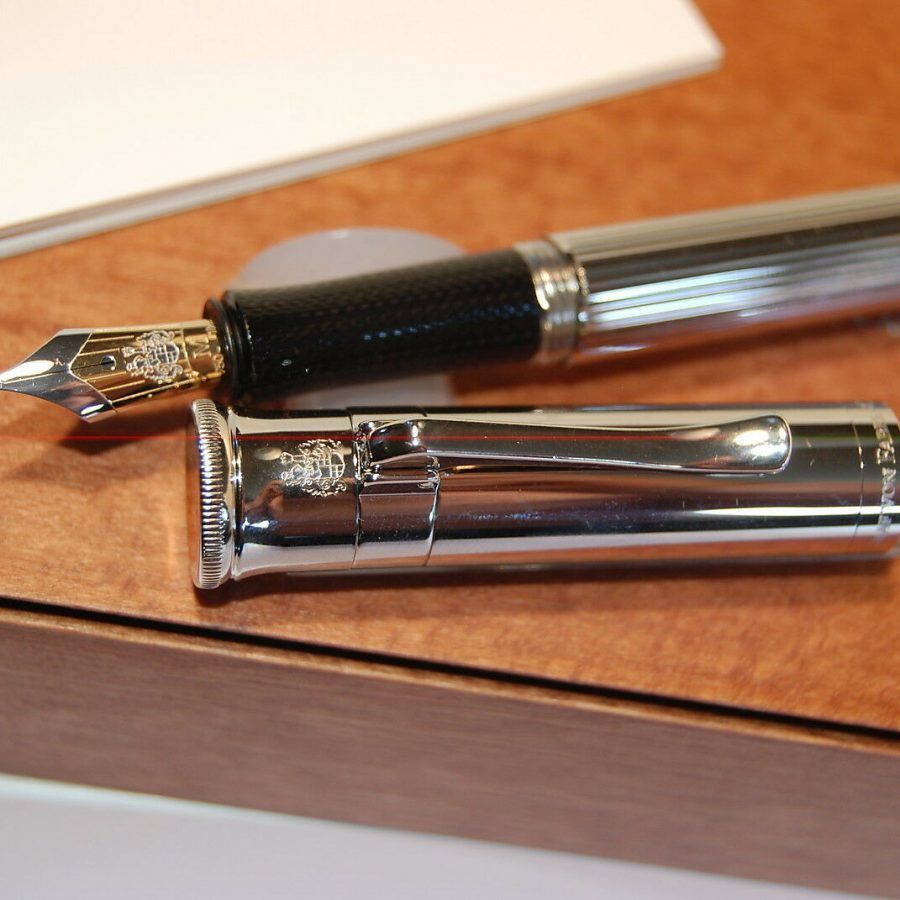
Faber Castell Fountain Pen Platinum Classic Nib Size M New
375,00€FABER CASTELL CLASSIC PLATINUM
The Classic range uniquely combines the warm, natural character of wood with the cool elegance of platinum-plated surfaces. In the different versions, they combine grooved bodies bathed in platinum or in Pernambuco, ebony or grenadille wood with platinum finishes. The natural variations in color and texture make each of the pieces made with these woods unique and unrepeatable.
Cartridge/converter system that is gently removed from the body by twisting the cap
Hand-tested bicolour 18-carat gold nib with iridium tip
The manufacturing process consists of more than a hundred steps, most of them done by hand -
![]()
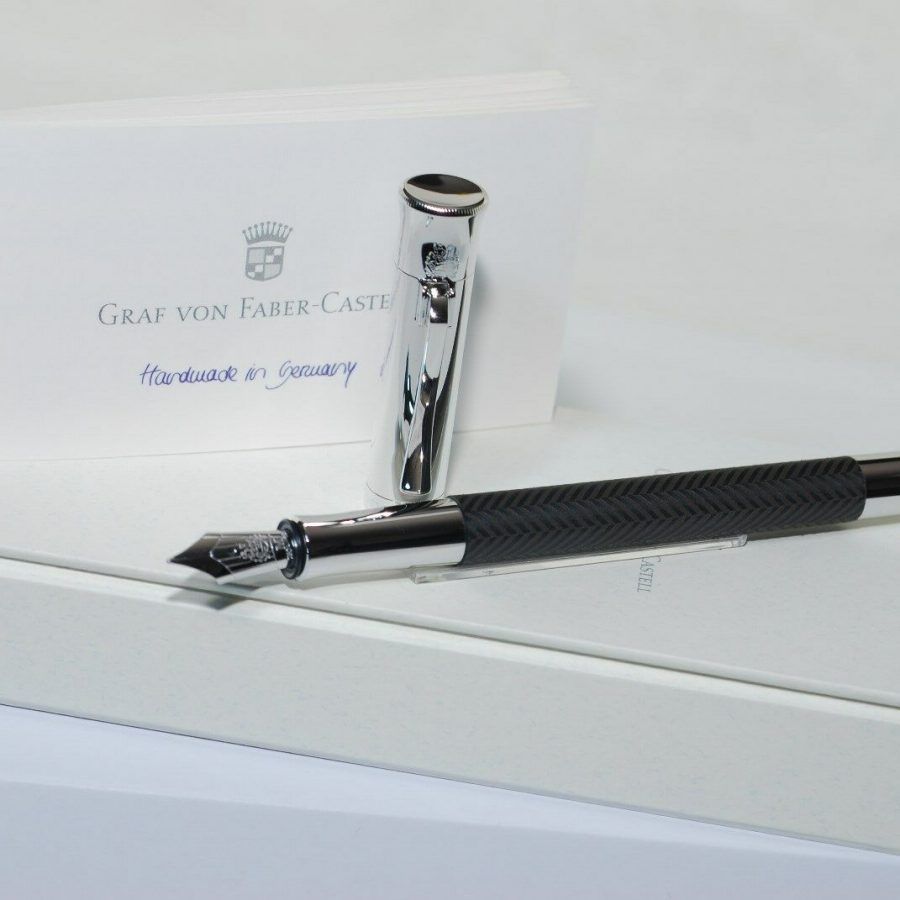
Faber-Castell Guilloche Brown Fountain Pen
275,00€The Guilloche writing instruments made of precious resin are distinguished by a special process. Each one is engraved individually using a method otherwise reserved for jewellery or silver accessories. The barrel is then hand-lacquered and repeatedly polished.The result is a unique and most interesting surface texture. No two writing implements are identical: each is an individual example of the craftsman’s art.
- Cartridge/converter system
- Hand-made 18-carat gold nib, rhodium plated, “run in” by hand
- Manufacturing process involves over a hundred steps, most of them carried out by hand
- Available nib widths are M (medium), F (fine), EF (extra fine), B (broad), OM (medium/ left slent) and OB (broad/ left slent)
-
![]()
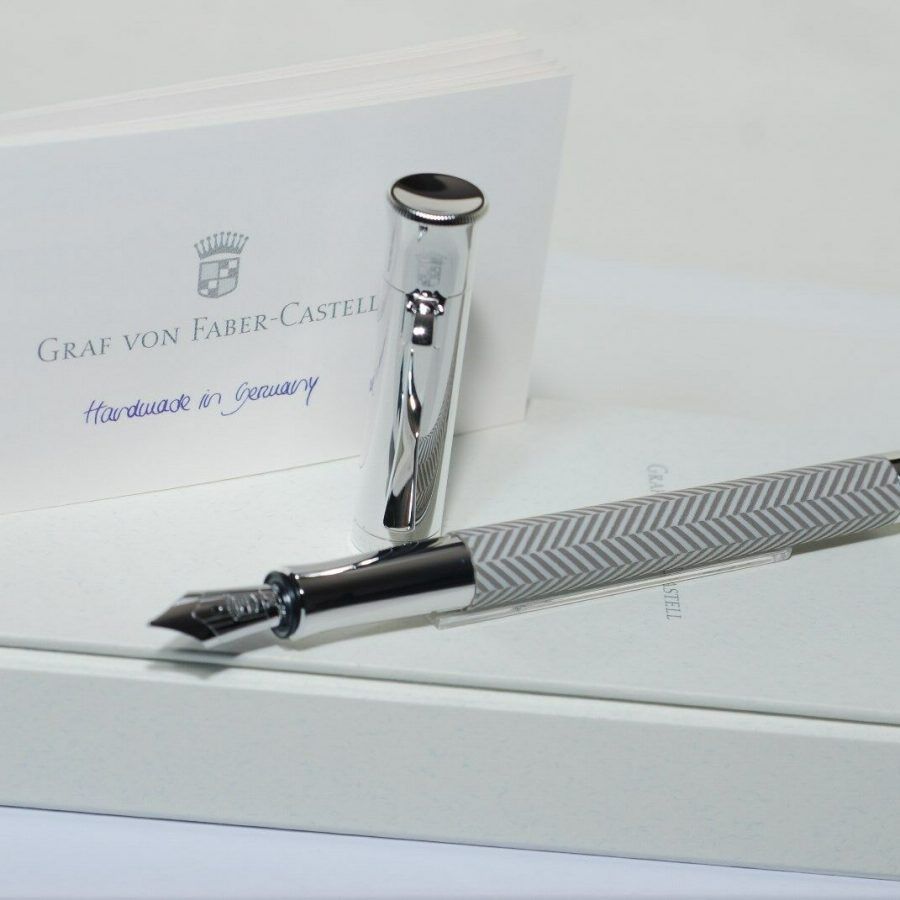
Faber-Castell Guilloche Light Grey Fountain Pen
275,00€The Guilloche writing instruments made of precious resin are distinguished by a special process. Each one is engraved individually using a method otherwise reserved for jewellery or silver accessories. The barrel is then hand-lacquered and repeatedly polished.The result is a unique and most interesting surface texture. No two writing implements are identical: each is an individual example of the craftsman’s art.
- Cartridge/converter system
- Hand-made 18-carat gold nib, rhodium plated, “run in” by hand
- Manufacturing process involves over a hundred steps, most of them carried out by hand
- Available nib widths are M (medium), F (fine), EF (extra fine), B (broad), OM (medium/ left slent) and OB (broad/ left slent)
- 1
- 2


 Español
Español 